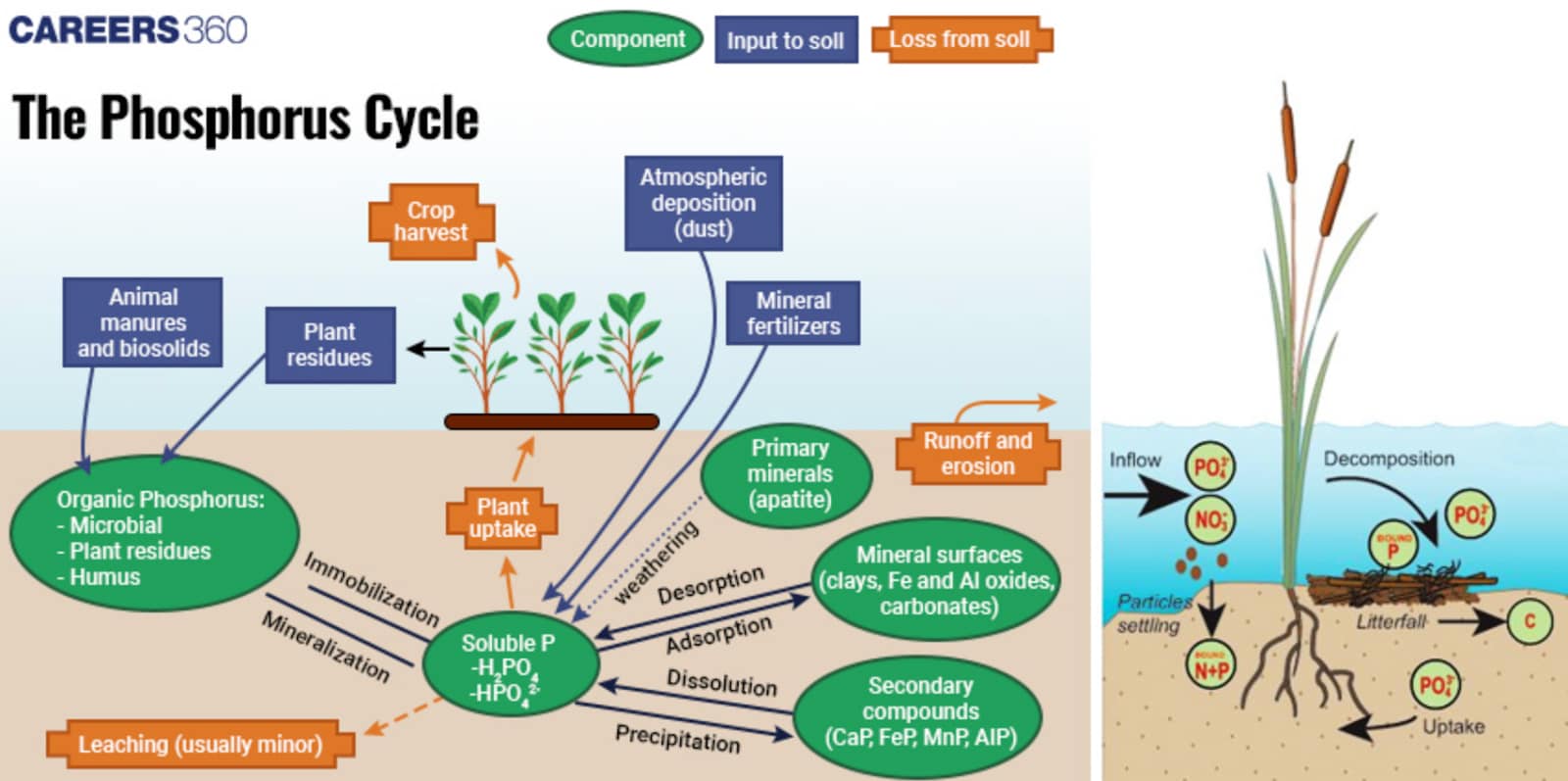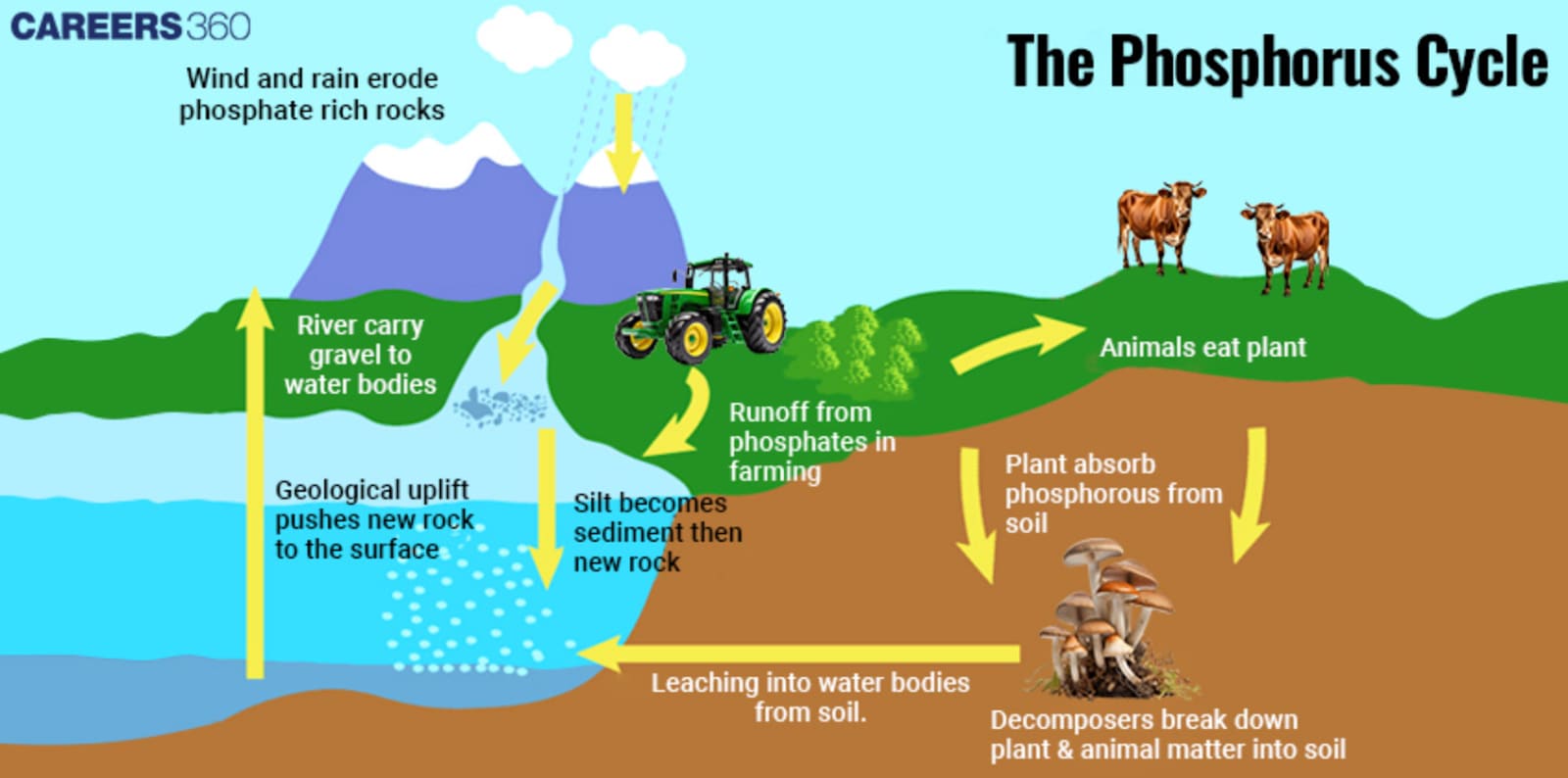Phosphorus cycle: Definition, Steps, Examples, Importance, Topics
Phosphorous cycle definition- The phosphorus cycle is the biogeochemical cycle that lists the movement of phosphorus through the lithosphere, hydrosphere, and biosphere. Unlike other cycles, phosphorus does not circulate in the atmosphere as a gas. Phosphorus is an essential nutrient for plants and animals, as it forms a key part of molecules like DNA, RNA, and ATP, which store and transfer energy in cells. In this article, the phosphorus cycle, phosphorus in nature, and steps of the phosphorus cycle are discussed. Phosphorous cycle is a topic of the Ecosystem in Biology.
NEET 2025: Mock Test Series | Syllabus | High Scoring Topics | PYQs
NEET Important PYQ's Subject wise: Physics | Chemistry | Biology
New: Meet Careers360 B.Tech/NEET Experts in your City | Book your Seat now
- What is a Phosphorus Biogeochemical Cycle?
- Phosphorus in Nature
- Phosphorus Cycle Steps
- Human Impact on the Phosphorus Cycle
- Recommended video for Phosphorus Cycle

What is a Phosphorus Biogeochemical Cycle?
The phosphorus cycle is defined as the circulation of phosphorus in the lithosphere, the hydrosphere, and the biosphere. Phosphorus is vital for all living things, needed in the advancement of DNA and RNA synthesis, ATP and the rising of cell membranes. In the aspect of phosphorus, the movement is between the pillars, Ions, rocks, water, and living things where phosphorus is released through the weathering of rocks, and dissolving into the soil and water, plant uptake, animal ingestion and is released back to the Ions, rocks and water through decomposition. It is an important cycle as far as phosphorus supply in ecosystems and biological production is concerned.
Phosphorus in Nature
The phosphorous in nature is listed below-
Sources of Phosphorus
The sources of phosphorous are listed below-
Rocks and minerals
Phosphorus is usually obtained from rocks and minerals common minerals, unlike fertilizers that obtain the said element from phosphate ores like apatite. Over time, known as the ecological time scale, these minerals undergo weathering to release phosphorus in the soil and the water.
Soil and water
Phosphorus is in the form of phosphate ions (PO32-) in the soil and dissolved orthophosphate in water bodies. On land, phosphorus has mobile particles and can be found in the soil and within particulate and dissolved-organic matter while in the water, it converts between sediment and water column.

Also read-
- MCQ Practice on Productivity on Phosphorous Cycle
- Ecosystem
- Energy Flow in Ecosystem
- Biotic and Abiotic Components of Ecosystem
Phosphorus Cycle Steps
The steps of the phosphorous cycle in the ecosystem are described below-
Weathering of Rocks
Phosphorus is mobilized through the release process from rocks and minerals due to weathering; it is a process through which phosphate minerals disintegrate as a result of physical and chemical weathering.
Absorption by Plants
The third component, phosphate ions (PO43-), is taken up by plants through the root system from the soil. Phosphorus is needed in plant nutrition as it is a constituent of DNA, RNA, ATP and cellular membranes.
Consumption by Animals
Like other nutrients phosphorus is ingested by the animals from plants or other animals. Phosphorus is body stored and is essential in many tissues hence playing key roles in cell structuring, bone formation and energy production.
Decomposition
Overall, phosphorus cycles in basic ways; it is produced from ingredient deposits when plants and animals decay and mineralized when nitrogen by microorganisms or decomposition. Decomposers act upon organic matter discharging phosphate ions to the soil solution at the same time.
Sedimentation
Phosphorus can also be transported from terrestrial to aquatic systems using run-offs and soil erosion. Phosphorus in the aquatic environment can sink and deposit onto bottom deposits at a later time.
Geological Uplift
Then, sedimentary phosphorus which has been mobilized into oceans over geologic time scales may experience other geological uplift processes whereby phosphorus-containing sediments are brought to new terrains and landforms or weather anew.
Phosphorous cycle diagram

Human Impact on the Phosphorus Cycle
Human activities have significantly altered the phosphorus cycle, leading to both beneficial and detrimental effects on ecosystems and the environment:
Agriculture and Fertilizer Use
Phosphate fertilizers are widely used intensively for increasing the rate of crop production. accidently, when fertilization is excessive then it leads to the accumulation of phosphorus in water bodies resulting in eutrophication which is a process by which the production of oxygen is countered resulting in the formation of non-sustainable ecological systems.
Industrial Activities
Some of the industrial fields include mining and manufacturing which release phosphorus into the environment through the discharge of wastewater and emissions. These activities can make phosphorus get into the water and the soil and thus interfere with the ecosystems of the region.
Waste Management
Often phosphorus is released into water systems by poor disposal of organic wastes, sewage and agricultural runoff. Wastewater treatment plants commonly found in urban areas fail to remove phosphorus, and the amounts end up disposed of in rivers, lakes, and coastal regions.
Environmental Consequences (Eutrophication)
Phosphorus pollution is one of the major impacts of human activities in aquatic ecosystems that lead to the occurrence of eutrophication. An overabundance of phosphorus causes the growth of algae, which decreases water transparency, prevents penetration of sunlight and expends the oxygen supply on the decomposition of dead algae.
This process interrupts the life systems of water bodies hurts fish and might culminate in the development of hypoxic zones known as dead zones.
Also Read-
| Acclimatization | Biomass definition ecology |
| Aquatic ecosystem | Biome definition |
| Biomass | Biomes of the world |
Recommended video for Phosphorus Cycle
Frequently Asked Questions (FAQs)
The phosphorus cycle outlines the factors through which phosphorus flows in the earth’s structures by geological, biological, and chemical processes. It is important because phosphorus is a critical part of DNA, RNA, ATP and cell membranes with a central role in energy transfer and life processes associated with an organism’s growth.
Phosphorus is one of the nutrients that move in the soil, water, and among the different forms of life. It is in rocks, accessed by weathering, taken by plants from the soil, ingested by animals, returned to the soil through burying, and can get to water by percolation.
Hoe farming (use of fertilizers), and industries (wastewater), fail in proper waste disposal and contribute to the increased level of Phosphorus in water. This leads to decreased dissolved oxygen levels, eutrophication, effects of the algal blooms on the aquatic lives and disturbance of the natural ecosystem balances.
Interfering with the phosphorus cycle results in eutrophication which brings about a poor quality of water, poor habitat for the aquatic animals, and most of which develop a low oxygen region known as the ‘dead zone’. It also has implications for the state of biodiversity and the balance of ecosystems.
Thus, sustainable management involves such practices as decreasing application rates of fertilizer products, increasing effluent treatment to mitigate phosphorus release, introducing soil protection measures, and increasing the public’s ecological literacy to counter phosphorus contamination of environments.
Also Read
29 Nov'24 01:08 PM
25 Nov'24 08:54 AM
21 Nov'24 03:53 PM
21 Nov'24 01:52 PM
15 Nov'24 02:15 PM
14 Nov'24 09:05 AM
14 Nov'24 08:45 AM
13 Nov'24 10:19 PM